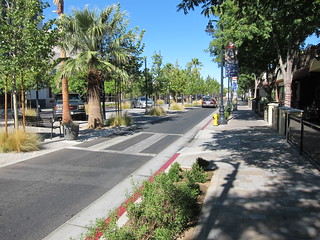
Resource Library
 We frequently hear about successful programs getting more youth bicycling and walking to school. But behind those programs are one or more dedicated people, often teachers that make it happen. Pat Davidson is one of them.
We frequently hear about successful programs getting more youth bicycling and walking to school. But behind those programs are one or more dedicated people, often teachers that make it happen. Pat Davidson is one of them.
 In Safe Routes to School we see countless examples of elementary schools led by passionate adults and fanatical students that knock walking and bicycling out of the proverbial park – but, as a movement, I believe we struggle to connect as frequently and in meaningful ways around active transportation with both middle and high school age students.
In Safe Routes to School we see countless examples of elementary schools led by passionate adults and fanatical students that knock walking and bicycling out of the proverbial park – but, as a movement, I believe we struggle to connect as frequently and in meaningful ways around active transportation with both middle and high school age students.

 With the issuance of the new interim guidance for the new Transportation Alternatives program under MAP-21, we now know for sure that future Safe Routes to School projects no longer have the luxury of being 100 percent funded by federal transportation dollars. Now, project sponsors will need
With the issuance of the new interim guidance for the new Transportation Alternatives program under MAP-21, we now know for sure that future Safe Routes to School projects no longer have the luxury of being 100 percent funded by federal transportation dollars. Now, project sponsors will need
This website provides information about pedestrian and bicyclist safety policy and program initiatives by the FHWA.
 We have had a lot to be thankful for recently, excepting the lasting and tragic human impact of hurricane Sandy.
We have had a lot to be thankful for recently, excepting the lasting and tragic human impact of hurricane Sandy.
 It has been a productive year for the Safe Routes Partnership in Southern California. This year, the Southern California team was off and running with a full-blown campaign at the Southern California Association of Governments (SCAG) to increase funding for active transportation in the 2012 Regional Transportation Plan and Sustainable Communities Strategy (RTP/SCS).
It has been a productive year for the Safe Routes Partnership in Southern California. This year, the Southern California team was off and running with a full-blown campaign at the Southern California Association of Governments (SCAG) to increase funding for active transportation in the 2012 Regional Transportation Plan and Sustainable Communities Strategy (RTP/SCS).
Improving the Grade describes how attendance-based financing hurts struggling school districts serving poor children and offer policy solutions that support student health and academic success.
 Moments ago I finished facilitating a webinar on regional approaches to Safe Routes to School through Metropolitan Planning Organizations (MPOS). The jargon involved even when clearly presenting on this topic would send even the most hardened Safe Routes to School practitioner running in the other direction. Yet, this is the point.
Moments ago I finished facilitating a webinar on regional approaches to Safe Routes to School through Metropolitan Planning Organizations (MPOS). The jargon involved even when clearly presenting on this topic would send even the most hardened Safe Routes to School practitioner running in the other direction. Yet, this is the point.
This fact sheet describes the impact of transportation funding recissions on transportation enhancements for biking and walking infrastructure and ways to protect funding for these projects and programs.
 In the past, community churches have typically served as places of worship. These institutions have been sustained by providing valuable contributions to communities in the areas of direct economic contributions, social services and community volunteering and education. This highlights the expanded role of the church from the church w
In the past, community churches have typically served as places of worship. These institutions have been sustained by providing valuable contributions to communities in the areas of direct economic contributions, social services and community volunteering and education. This highlights the expanded role of the church from the church w
The purpose of this document is to show that bicycle and pedestrian projects are eligible for funding through CMAQ, describe the criteria and process, provide examples of successful projects, and give advice for answering tough questions.
The Safe Routes Partnership launched the State Network Project in 2007 to influence state-level Safe Routes to School implementation and to leverage additional resources and build a supportive environment through other state-level policies.
 We have all been waiting to learn how the new federal transportation bill, Moving Ahead for Progress in the 21st Century, or MAP-21, will be implemented. The new Transportation Alternatives Program (TAP) is of particular interest since it now includes Safe Routes to School and Transportation Enhancements funding.
We have all been waiting to learn how the new federal transportation bill, Moving Ahead for Progress in the 21st Century, or MAP-21, will be implemented. The new Transportation Alternatives Program (TAP) is of particular interest since it now includes Safe Routes to School and Transportation Enhancements funding.
The aim of the Active School Neighborhood Checklist (ASNC) is to provide decision makers with a quantitative tool for evaluating the potential long-term health impacts of candidate school sites on the children who will attend them.
 Leah Murphy is a currently a Master's Student at the University of California Los Angeles.
Leah Murphy is a currently a Master's Student at the University of California Los Angeles.
This resource provides information about developing funding and policy support for joint use of school facilities.


